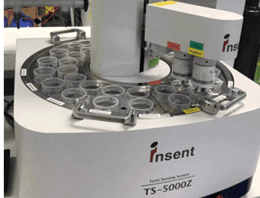AUSTRALIAN researchers trialling an electronic tongue – or ‘e-tongue’ – report that instrumental taste measurements successfully detected spoiled vacuum-packed mince.
Their preliminary research could help overcome the difficulties industry faces detecting ‘off’ meat.

Dr Matthew Wilson
Lead researcher, Dr Matthew Wilson said due to food safety considerations, humans cannot be directly used to determine sensory shelf-life acceptability limits of raw meats from taste testing.
“Our study has demonstrated that e-tongue measurements may have a role to play in practical prediction models in this field,” Dr Wilson said.
The research team included scientists from the University of Tasmania and the University of Adelaide. They reported that the e-tongue may be more useful for modelling sourness, umami and odour than existing microbial-based shelf-life measurements using lactic acid bacteria (LAB) numbers or the total viable count (TVC).
 They also reported that sourness, umami and pH values can be combined to predict spoiled beef odour scores.
They also reported that sourness, umami and pH values can be combined to predict spoiled beef odour scores.
Their work was also the first attempt to describe the shelf-life of vacuum-packed meat at different storage temperatures and durations using estimations of taste, as well as through measuring volatile profiles.
In commercial settings, TVC and LAB concentration limits are typically used as part of microbiological specifications to assess the acceptability and safety of meat.

Dr Wilson said: “However, these traditional microbial measures of spoilage do not necessarily reflect the true status of meat quality, especially as perceived by consumers. They can also be time-consuming and expensive to measure.
Changes in meat sensory quality during storage are difficult to assess accurately and objectively, he said.
“While considerable information is known on the identity of spoilage organisms of chilled vacuum-packed beef, and the chemical changes and safety considerations that can result from their growth, direct information on changes in taste due to microbial growth is limited.
“To help in reducing food waste, better models for prediction of meat spoilage are needed.”

Electronic tongue
In this study, vacuum-packed minced beef was incubated at four different temperatures until the end of its quality shelf-life, before researchers conducted instrumental taste analysis with an e-tongue and analysis of volatile compounds.
“The results in our study demonstrated that e-tongue measurements can complement bacterial counts in assessing the extent of meat spoilage” co-author Dr Samantha Sawyer said.
“Sourness and umami e-tongue measures appear to respond to storage temperature and storage time in a similar way to odour sensory scores and in this study this was a clearer relationship than with pH and the measurements of LAB and TVC,” Dr Wilson said.
She emphasised that the study was preliminary.
“Repeating these experiments with multiple sources of meat is needed to demonstrate that an instrumental sensory approach to shelf-life could be developed into an industrially useful model.”
Other researchers involved in the work were Ian Hunt, Chawalit Kocharunchitt, Zeer Li and Roger Stanley.
Behind the science:
Lactic acid bacteria (LAB) are a dominant organism on vacuum-packed meat. In vacuum-packed beef, spoilage associated with LAB produces a sour taste, and can emit cheesy odours.
When LAB are growing, lactic acid and acetic acid are produced, which affect the taste, smell and colour of food. This leads to sourness increasing in intensity over time. Sourness is likely to be considered a ‘bad taste’ for fresh meat by most consumers, serving as a warning sign that food is spoiled.
Umami taste is an important factor in the flavour characteristics and palatability of meat, with higher levels of umami often associated with higher quality products.

HAVE YOUR SAY